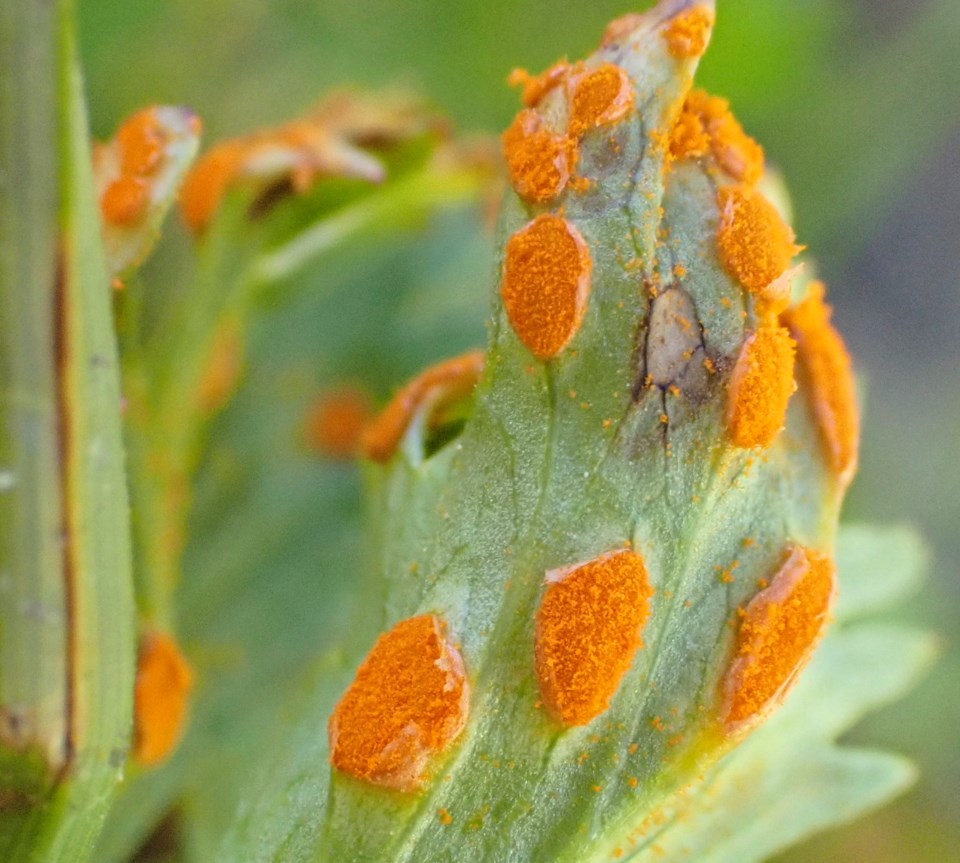Have you ever been walking in nature, when all of a sudden a bright, orange blob on a leaf or twig snatched your attention? Upon closer inspection, you see it’s not a flower, or a piece of trash, but something stuck to a plant, and may appear hard and dark or perhaps bright and powdery? You, my inquisitive hiker, have stumbled upon a rust fungus!
While they may look like oxidized metal or a ball of orange Silly String, rust fungi are indeed a member of the fungi kingdom. There are roughly 7,000 species of rust fungi, but there are likely many more out there waiting to be discovered.
Rust fungi come in a variety of hues, from orange and yellow to brown and black, and of course rusty. They are commonly observed on plant leaves, stems, and fruits, where they create distinctive pustules or lesions, which are akin to the fun warts seen on squashes and pumpkins this time of year. Rusts can be found infecting a wide range of native plants, including: Western Meadowrue (Thalictrum occidentale), Fan-leaved Cinquefoil (Potentilla flabellifolia), and on various pine, fir, huckleberry and rose species, to name a few.
To add to their intrigue and mysteriousness, rust fungi are highly specialized plant pathogens (diseases) that often require a specific host species for reproduction. A basic explanation of their life cycle begins with spores being carried by wind, water, or insects, which eventually land on a plant. After penetrating through the plant’s surface and into the mesophyll cells, the fungi’s hyphae develop and spread, just like other fungi. Within eight to 10 days (depending on the host plant), rust fungi fruiting bodies form, creating deformities like witch’s broom, cankers, growths, and yellowing of leaves, which then release their own spores. While these gnarly growths may elicit sympathies from us, most species of rusts do not kill the host plant—but they can create openings for diseases or pests to invade and cause chaos.
For farmers and large-scale agriculture, rust fungi is often associated with harmful plant diseases and even crop failure, but they have important ecological roles in our natural areas. Rust fungi aid in the decomposition of plant material, which release nutrients back into the soil. Like other plant parasites that depend on living hosts, rusts play an important role in shaping plant communities and promoting diversity through coevolution with their host plants. Biodiversity, babe! Biodiversity is crucial in the era of climate change because it enhances ecosystem resilience, enabling ecosystems to better adapt to and mitigate the impacts of changing environmental conditions.
While mushrooms such as large red and white russulas, the striations of turkey tail polypores, or candy-like waxcaps may draw your attention during fall hikes, don’t dismiss the humble rust fungi. These fungi play a critical role in maintaining the health and diversity of the local flora, showcasing the intricate web of life that thrives in this beautiful corner of British Columbia.
So, next time you explore the forests of Whistler and beyond, don’t let this fungi’s somewhat grotesque appearance stop you from taking a closer look.
The Whistler Naturalists just hosted the 21st annual Fungus Among Us Mushroom Festival Oct. 13 and 14. For a recap of the event, please visit our website.
Naturespeak is prepared by the Whistler Naturalists. To learn more about Whistler’s natural world, go to whistlernaturalists.ca.




